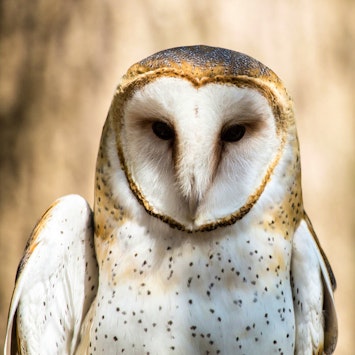A "ghost" with a most unusual face
Discovery Place Nature

Take a moment to ponder your favorite activities. Crawling around in dark, musty crawl spaces or attics is probably not to be on the top of your list, is it?
You might expect to encounter spiders, snakes, squirrels, centipedes or even an opossum in that environment. But what about something from the great beyond?
In fact, areas like that give you a good chance to spot a very strange creature. And the older the building is, the better your odds. If it has sat empty and neglected for a number of years -- if it has reached a maximum factor of creepiness -- you are nearly guaranteed to see a ghost.
Or a banshee.
Well, it’s not a lingering spirit, exactly. It might seem like it, as it rushes by with a flash of white and a horrible screeching sound that sounds nothing at all like what you believe an owl should sound like. No, this noise is more akin to something off a horror movie soundtrack. It’s so sharp, sudden and shrill that it sounds like a cross between a little girl’s scream and nails on a chalkboard.
But that is the call of the barn owl.
As the name implies, these owls love the spaces we build, and the mice and rats that follow us into our dwellings. They also enjoy consuming small songbirds and ground-dwelling birds like killdeer.
Just like humans have spread all over the world, so have barn owls. There are various sub-species. Almost every continent on Earth has its own barn owl population.
Barn owls have very long legs in proportion to their bodies, which makes them a little scary to look at, along with their huge, empty-looking black eyes. Their tannish-white feathers, lightly mottled, are attractive. But their most endearing feature is their heart-shaped face.
These disk-like feather arrangements make the owl’s face work sort of like a satellite dish, funneling sound into one side of their lopsided ear canals. The ear opening on the left side of their faces (when viewed from the front) is larger and higher up on the skull than the ear opening on the right.
Their brains make the calculations between the differences each ear discerns and help these owls lock onto their scampering, whiskered prey with deadly accuracy.
They dispatch their lunch with a quick squeeze of their modified claws, called talons. Thick skin on the talons and a scattering of downy feathers protect the owl from the bites of their intended meals.
Unlike most owls, they aren’t selective or fussy about their nest. Usually a few twigs and a nice flat surface will suffice. They’re often found in attics, parking decks, tree cavities, silos, chimneys, above-ground basements with an open window and, of course, the haylofts of barns.
So the next time you think you’ve had a paranormal encounter, turn around and check again. Let your heart slow down a moment before watching this mysterious and graceful hunter take flight. He didn’t mean to give you a fright, and you startled him too!



